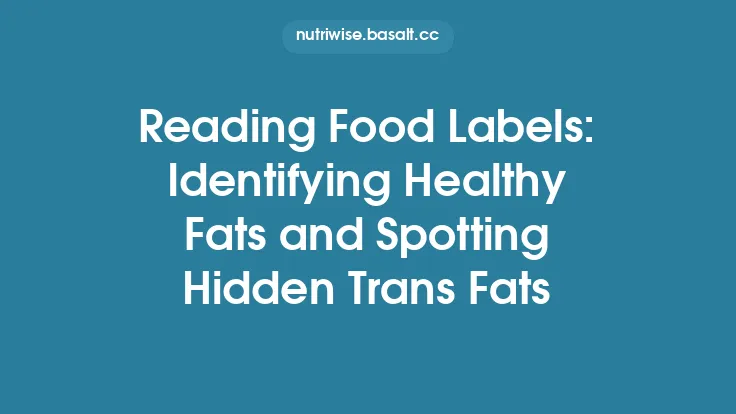Low‑fat labels have become a staple on grocery shelves, promising a healthier alternative to their full‑fat counterparts. Yet the reality is far more nuanced. While reducing fat can lower the calorie density of a product, manufacturers often compensate for the loss of flavor, texture, and mouthfeel by adding sugars, refined starches, or other additives that can undermine weight‑management goals. Understanding how these substitutions work, what “low‑fat” actually means on a nutrition label, and how the body responds to altered macronutrient profiles is essential for anyone trying to make informed choices.
The Regulatory Definition of “Low‑Fat”
In most jurisdictions, a product can be labeled “low‑fat” only if it contains 3 g of fat or less per serving (or 30 % of the Daily Value for fat). This definition is purely quantitative and does not consider the overall nutritional quality of the food. A snack bar that meets the 3‑gram threshold might still be high in added sugars, refined carbohydrates, or sodium, all of which can influence hunger, energy balance, and long‑term health.
Key points to remember:
- Serving size manipulation – Manufacturers may shrink the declared serving size to meet the low‑fat criterion, making the product appear healthier while the total amount consumed in a typical eating occasion remains unchanged or even increases.
- Percent Daily Value (DV) confusion – The 30 % DV reference is based on a 2,000‑calorie diet, which may not reflect an individual’s actual caloric needs, especially for those actively managing weight.
Fat’s Role in Satiety and Energy Regulation
Dietary fat is the most energy‑dense macronutrient, providing 9 kcal per gram, compared with 4 kcal per gram for carbohydrates and protein. However, its physiological effects extend beyond simple calorie counting:
- Satiety signaling – Fat slows gastric emptying and stimulates the release of hormones such as cholecystokinin (CCK) and peptide YY (PYY), which promote feelings of fullness. When fat is removed, these signals are blunted, often leading to increased overall food intake.
- Flavor enhancement – Fat carries flavor compounds and contributes to the creamy, satisfying mouthfeel that many people associate with indulgent foods. In its absence, manufacturers may add sweeteners or salt to compensate, which can trigger cravings and over‑consumption.
- Nutrient absorption – Certain vitamins (A, D, E, K) are fat‑soluble. Low‑fat products that lack adequate fat may impair the absorption of these micronutrients unless the diet includes other fat sources.
Hidden Additions: Sugar, Starch, and “Fat Replacers”
When fat is stripped from a product, the resulting loss in texture and taste must be addressed. The most common strategies include:
- Added sugars – To restore sweetness and palatability, manufacturers often increase sugar content. This not only raises the total caloric load but also spikes blood glucose, potentially leading to increased hunger shortly after consumption.
- Refined starches and gums – Ingredients like maltodextrin, modified food starch, cellulose gum, or carrageenan can mimic the mouthfeel of fat. While they are low in fat, they are typically high‑glycemic and can contribute to rapid energy spikes.
- Fat mimetics – Some products use protein‑based or carbohydrate‑based fat replacers (e.g., microparticulated whey protein, olestra). Although they reduce fat content, they may not provide the same satiety signals and can sometimes cause gastrointestinal discomfort, which may affect eating patterns.
The “Calorie‑For‑Calorie” Fallacy
A common misconception is that swapping a full‑fat item for a low‑fat version automatically reduces caloric intake. In practice, the calorie reduction is often modest because:
- Compensatory ingredients – Added sugars and refined carbs can offset the calories saved by removing fat.
- Portion distortion – Low‑fat foods are sometimes marketed as “diet” or “light,” encouraging larger portions under the assumption that they are “free” calories.
For example, a 100‑g serving of regular mayonnaise (≈ 700 kcal) may be replaced with a low‑fat version (≈ 300 kcal). However, if the low‑fat version contains added sugars and the consumer doubles the serving size to achieve the same perceived richness, the net caloric intake may be similar or even higher.
Psychological Influences: The “Health Halo” Effect
Labeling a product as low‑fat creates a health halo, leading consumers to perceive the item as universally healthier. This perception can:
- Reduce vigilance – People may be less attentive to other nutritional cues (e.g., sugar, sodium) when a product is labeled low‑fat.
- Encourage over‑eating – Believing a food is “light” can justify larger portions or additional snacking, inadvertently increasing total energy intake.
Whole Foods vs. Processed Low‑Fat Products
The degree to which low‑fat labeling misleads depends heavily on the food matrix:
- Whole foods – Naturally low‑fat foods such as fruits, vegetables, legumes, and lean proteins typically do not require added sugars or starches to be palatable. Their nutrient density remains high, and they support satiety through fiber and protein.
- Processed foods – Low‑fat versions of cookies, crackers, dressings, and dairy desserts are more likely to contain hidden sugars, refined carbs, and additives. The processing steps often strip away beneficial components (fiber, micronutrients) while adding less desirable ones.
Choosing whole, minimally processed foods reduces the risk of inadvertently consuming hidden calories and preserves the natural satiety mechanisms associated with dietary fat.
Practical Strategies for Navigating Low‑Fat Labels
- Read the full nutrition facts panel – Look beyond the “fat” line. Examine total sugars, added sugars, and carbohydrate content per serving.
- Check the ingredient list – Ingredients are listed in order of predominance. If sugar, high‑fructose corn syrup, maltodextrin, or other sweeteners appear near the top, the product may be compensating for reduced fat.
- Compare serving sizes – Ensure the serving size aligns with realistic consumption. If the listed serving is unusually small, calculate the nutrients for the amount you actually eat.
- Prioritize protein and fiber – Foods that combine low fat with adequate protein and fiber tend to be more satiating and supportive of weight management.
- Consider the overall dietary pattern – A single low‑fat item does not define a diet. Focus on balanced meals that include healthy fats (e.g., nuts, seeds, avocados, oily fish) to maintain satiety and nutrient adequacy.
When Low‑Fat Can Be Beneficial
Low‑fat options are not inherently detrimental. They can be useful in specific contexts:
- Medical dietary restrictions – Individuals with certain lipid disorders or pancreatitis may require strict fat limitation.
- Calorie‑controlled meal plans – When paired with high‑protein, high‑fiber foods, low‑fat products can fit into a structured plan without excessive added sugars.
The key is to select low‑fat foods that are minimally processed and free of excessive sweeteners or refined starches.
Bottom Line
Low‑fat labeling is a marketing tool that can obscure the true nutritional profile of a product. While reducing fat can lower calorie density, the common practice of adding sugars, refined carbohydrates, and fat mimetics often neutralizes—or even reverses—the intended benefit for weight management. By scrutinizing nutrition facts, ingredient lists, and serving sizes, and by favoring whole, minimally processed foods, consumers can avoid the pitfalls of the low‑fat myth and make choices that genuinely support their weight‑management goals.





